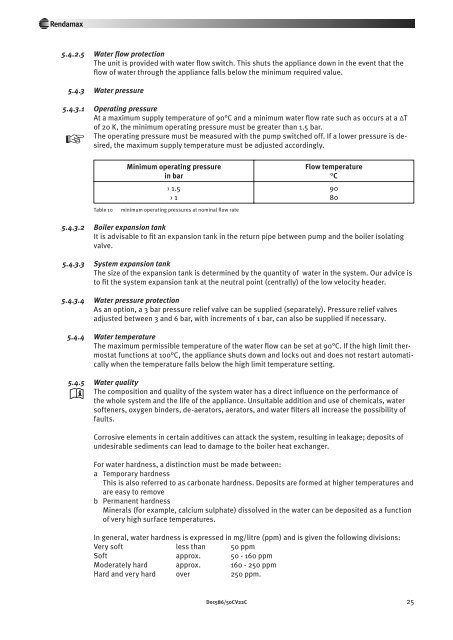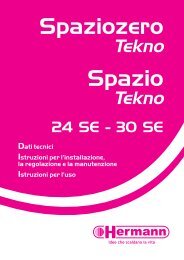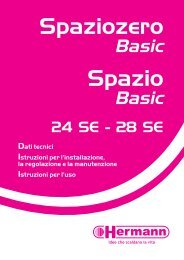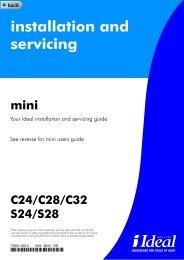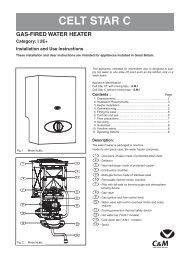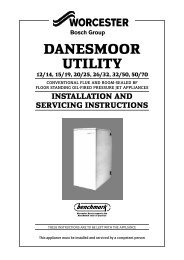sy24inst2 - The Initiative Group
sy24inst2 - The Initiative Group
sy24inst2 - The Initiative Group
Create successful ePaper yourself
Turn your PDF publications into a flip-book with our unique Google optimized e-Paper software.
Rendamax<br />
5.4.2.5 Water flow protection<br />
<strong>The</strong> unit is provided with water flow switch. This shuts the appliance down in the event that the<br />
flow of water through the appliance falls below the minimum required value.<br />
5.4.3 Water pressure<br />
5.4.3.1 Operating pressure<br />
At a maximum supply temperature of 90°C and a minimum water flow rate such as occurs at a ∆T<br />
of 20 K, the minimum operating pressure must be greater than 1.5 bar.<br />
<strong>The</strong> operating pressure must be measured with the pump switched off. If a lower pressure is desired,<br />
the maximum supply temperature must be adjusted<br />
y<br />
accordingly.<br />
Minimum operating pressure<br />
in bar<br />
› 1.5<br />
› 1<br />
Flow temperature<br />
°C<br />
90<br />
80<br />
Table 10<br />
minimum operating pressures at nominal flow rate<br />
5.4.3.2 Boiler expansion tank<br />
It is advisable to fit an expansion tank in the return pipe between pump and the boiler isolating<br />
valve.<br />
5.4.3.3 System expansion tank<br />
<strong>The</strong> size of the expansion tank is determined by the quantity of water in the system. Our advice is<br />
to fit the system expansion tank at the neutral point (centrally) of the low velocity header.<br />
5.4.3.4 Water pressure protection<br />
As an option, a 3 bar pressure relief valve can be supplied (separately). Pressure relief valves<br />
adjusted between 3 and 6 bar, with increments of 1 bar, can also be supplied if necessary.<br />
5.4.4 Water temperature<br />
<strong>The</strong> maximum permissible temperature of the water flow can be set at 90°C. If the high limit thermostat<br />
functions at 100°C, the appliance shuts down and locks out and does not restart automatically<br />
when the temperature falls below the high limit temperature setting.<br />
5.4.5 Water quality<br />
<strong>The</strong> composition and quality of the system water has a direct influence on the performance of<br />
x<br />
the whole system and the life of the appliance. Unsuitable addition and use of chemicals, water<br />
softeners, oxygen binders, de-aerators, aerators, and water filters all increase the possibility of<br />
faults.<br />
Corrosive elements in certain additives can attack the system, resulting in leakage; deposits of<br />
undesirable sediments can lead to damage to the boiler heat exchanger.<br />
For water hardness, a distinction must be made between:<br />
a Temporary hardness<br />
This is also referred to as carbonate hardness. Deposits are formed at higher temperatures and<br />
are easy to remove<br />
b Permanent hardness<br />
Minerals (for example, calcium sulphate) dissolved in the water can be deposited as a function<br />
of very high surface temperatures.<br />
In general, water hardness is expressed in mg/litre (ppm) and is given the following divisions:<br />
Very soft less than 50 ppm<br />
Soft approx. 50 - 160 ppm<br />
Moderately hard approx. 160 - 250 ppm<br />
Hard and very hard over 250 ppm.<br />
Doc586/50CV22C 25


